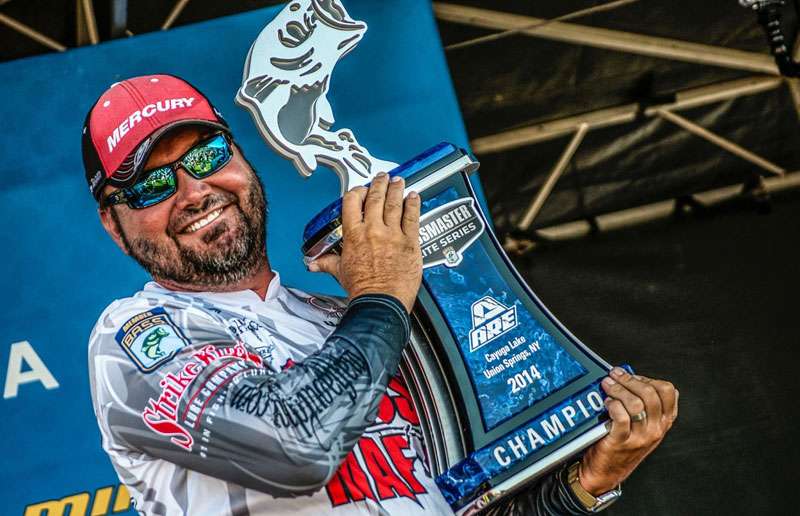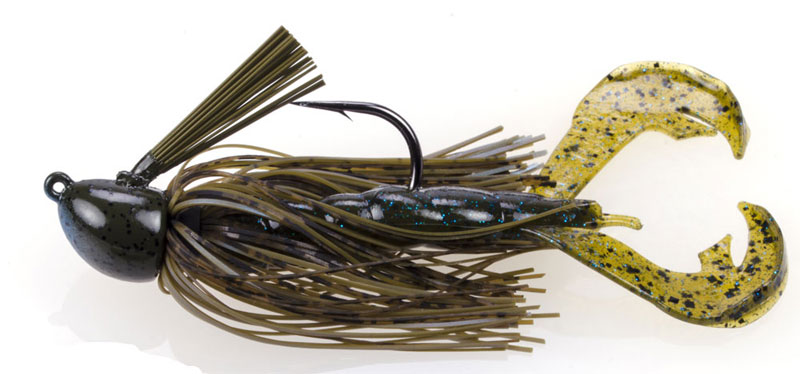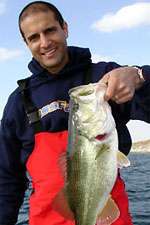
We all know Greg Hackney won the Bassmaster Elite Series tournament at Cayuga Lake, N.Y. using his namesake Strike King Hack Attack Jig. But how exactly did he get on the jig bite and where he was he fishing? Read on.
Practice: grass everywhere
Hackney said there was “grass everywhere” when he launched his boat for practice, so he “started out deep” – because when there’s lots of grass, he likes to start on the outside edge.
“It’s funny how practice goes,” he said. “I had a few bites, but at the time [deeper] didn’t seem that good. So I moved up shallow, and developed a pattern I thought would produce some big ones.
“I stayed on the grass. I did see a couple big fish on boat docks and hit waypoints when I saw them, but mostly just fished the outside or inside grassline.”
On the outside grassline, he found one deep school – “on a long grassline [on a flat] that had a real steep drop that swung into it in 14-17 feet. That’s where the fish were concentrated. I caught one deep, and when I reeled it up six or seven more fish were chasing it. I felt like it was a place I could catch a limit.”
Day 1: Deep, then shallow
“The first day of the tournament, I started on the deep fish to try to catch a limit,” he said. “I thought they were 3-pounders.
“I dropped a jig on them, had six bites but only caught three: two 4s and a 3 3/4. Then I left it, fished around there a little then went up shallow.” He caught two big ones shallow and ended up with a high-teens sack.
Days 2-4: Deep only
“The second morning I went to the deep fish again, pulled up there and was a little more dialed in,” he said. “This time I only had four bites, but they were all big: two 5s and two 4s.
“Once I saw the potential of that bite, that’s all I did the rest of the day. I practiced, looking for more places like that – and shortly after that I caught a 3 3/4 deep.
“I ran to new water and culled a 4-pounder with a 5, which gave me at that time the biggest stringer of the tournament.”
After that, “I pretty much got one-dimensional,” he said. “On Day 3 I started in the same spot and had four bites, all big ones, but only caught three. Then I went to another [similar area] and caught another big one.”
He only weighed four fish that day because he kept fishing for big bites instead of a keeper fish. The wind that day made deeper fishing tough, and he never got another bigger fish.
“On Day 4, the conditions were perfect,” he said. After dialing in his deep pattern for 3 days of practice and 3 tournament days, things couldn’t have gone better.
“On my first spot I had a limit that was more than enough to win. Then I started going to those other places and caught a big one on every spot. I just kept upgrading, and had the big stringer of the tournament” (23-15).
Baits used
All his deep fish were caught on the Strike King Hack Attack Jig, both 1 and 1.25 ounce. “I fished the 1 ounce, then went to the 1.25 ounce to fish faster,” he said: The bass would only hit it on the initial drop.
Early each morning, when it was still sort of dark, he fished with a candy craw-colored jig paired with a junebug Strike King Rage Tail Rage Craw. Once the sun came up, he switched to his main colors: a blue craw Hack Attack Jig with a green pumpkin sapphire Rage Craw.

“The water was so clear, once the sun got out I thought that [blue craw/green pumpkin sapphire] color combination really represented those yellow perch and bluegill,” he explained.
His shallow-water bait, which he only used on Day 1, was a 1/2-ounce Strike King Rage Blade in green pumpkin. “I was fishing inside grasslines,” he noted.
Deep-jigging notes
- “Most of the fish were just 1-2 feet inside the grassline or were on the outside edge. That water was so clear that if they were going to get it, they got it really quick. So I’d hop it once or twice, then reel it in.”
- “You had to be precise. You had to hit the fish right on the head – they were not coming to get it. I made a lot of casts and was real thorough. That was the problem on Day 3 – the wind blew and I couldn’t make accurate presentations.”
- “I was basically just fishing down the bank. My boat was in 18-20 feet, and there was 150 feet of water right behind me. Sometimes I was 50 yards off the bank, but usually less. I liked that [steep bank] because the fish couldn’t get away from me.”
Other pattern notes
- “There were more numbers [of fish] shallow, but bigger ones were on the deeper edge of that grass.”
- “It was all about that jig bite. Most of the guys flipping grass during the tournament were using a punch skirt and plastic, or just a plastic. But I’m a firm believer that when they’re biting the jig, it catches the big ones.”
- “That Rage Craw generate bites. When I’m fishing like that and the fish are getting the baits quick, it just seems like the Rage Craw does the best job.”
- “I was surprised I never saw any sign of crawfish – the fish never spit up one in my livewell or anything. So I just figured bluegill and yellow perch were the deal.”
- “Anywhere I caught bass, I had to get perch bites. If I fished stretch of grass and I didn’t get any perch or bluegill bites, there wouldn’t be any bass there. Even shallow on the Rage Blade – [where he caught bass] either a bass would get it or a yellow perch would be following it to the boat.”
- “That tournament set up really well for me. I was doing something I have a lot of confidence in. I don’t know if I’m that good at it, but I’ll stay after it longer because I enjoy doing it so much.”
He flipped with a 7′ 11″ Quantum Greg Hackney Series Tour rod, Quantum EXO PT 100 reel and 50-pound Gamma braid.





